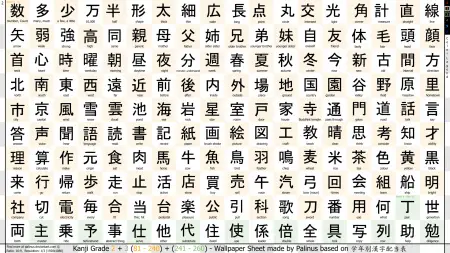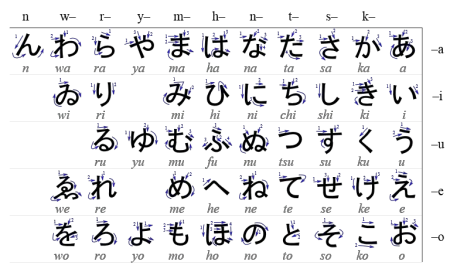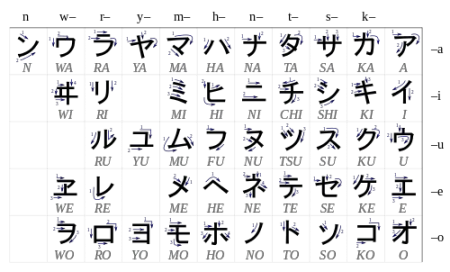Japanese writing is known to be one of the most complicated writing systems in the world. It uses the logographic character type kanji, and the syllabic character types hiragana and katakana. Kanji, hiragana and katakana are almost always used together in written sentences. This article will help you understand the differences among the three.
Summary Table
| Kanji | Hiragana | Katakana |
| Logographic – each character represents whole words or phrases | Syllabic – each character represents a corresponding phonetic sound | Syllabic – each character represents a corresponding phonetic sound |
| Used for blocks of ideas | Used for grammatical relationships between ideas or objects | Used for foreign names, names of foreign places, words of foreign origin, scientific and technical terms |
| Characters are usually complex, composed of multiple strokes | Characters are more curvy and have less edges | Characters are more rigid and have sharp edges |
Descriptions

Kanji is the system of Japanese writing that uses characters derived from the Chinese hanji. Kanji literally means “Han”, or Chinese characters. But Kanji characters are mainly used for native Japanese words.
Kanji is logographic, which means that each character represents a word or phrase to convey an idea. Each character may sometimes be read differently, depending on the context or how it is used together with other characters. Kanji is used for nouns, verbs, adverbs and adjectives.
The exact number of kanji characters is not known. The most commonly used ones number between 2,000 and 3,000, and there are thousands more that are occasionally and rarely used.
Many Kanji Have Multiple Potential Readings
One distinctive feature of Kanji is that many of them have more than one reading. In other words, the same Kanji can look the same but be pronounced for different words.
Isn’t that confusing?
The good news is that the meaning of the Kanji is determined by their context. What’s more, many of the Kanji have several readings, but a couple of them are more commonly used than the others.
There are also some words that have no way to be written in Kanji, so these are always written in Hiragana. The Japanese language also has words that can be written in Kanji, but they are always written in Hiragana instead. This can apply to words that are too difficult or not commonly used.

Hiragana is the basic Japanese phonetic language. It is the first system of writing Japanese children learn in school. Literally, it means “simple” kana.
Each hiragana character corresponds to one sound in the Japanese language, and holds no meaning by itself. There are 46 hiragana character symbols. A writer may express words in their syllabic equivalent as hiragana characters instead of writing the kanji symbol. This is useful for readers who are not familiar with kanji, or if the writer does not know the kanji characters for particular words. Hiragana may also be written in small script beside the kanji symbol to serve as a reading or pronunciation guide.
The hiragana in this case is referred to as furigana.
Hiragana is also used as suffixes in conjunction with kanji to give a particular meaning. This particular use for hiragana is called okurigana. Hiragana also provides grammatical structures to sentences. Short modifiers, called particles, are used together with nouns, verbs and adjectives. These particles are usually written using hiragana.

Katakana is the other syllabary used in Japanese writing. Together with hiragana, they are collectively called kana. Hiragana and katakana work the same way, where each katakana character has a corresponding syllable. Katakana means “fragmentary” kana, with characters derived from components of more complex kanji symbols. It is made up of 48 characters.
Katakana is mainly used for words of foreign, non-Chinese origin as well as foreign names and names of places. It is also used for technical and scientific terms, as well as for onomatopoeic words.
Why Does the Japanese Language Rely More on Kanji If Everything Can be Written in Hiragana?
The main reason the Japanese language relies on Kanji more often is that it’s more efficient and easier to read.
When Do Japanese People Start Learning Hiragana and Katakana?
It really depends on each family. Hiragana is used as furigana in many children’s books, so many parents try to teach their kids hiragana first. However, some parents believe that hiragana is more difficult for children to write, so they teach their kids katakana first.
In school, Hiragana is always taught first, but that wasn’t always the case. Before 1948, many schools in Japan taught their students katakana first.
Kanji vs Hiragana vs Katakana
So, what are the differences among kanji, hiragana and katakana?
Kanji are logographic characters that represent blocks of meaning and correspond to whole words or phrases. Hiragana and katakana are syllabic characters, with each character representing a sound or syllable. Hiragana is usually used to express the grammatical relationship between words in a sentence. It may also be used to replace kanji to express words in syllabic characters. Katakana, on the other hand, is used for foreign words, names, names of places, technical and scientific terms and onomatopoeic words. Kanji characters are derived from Chinese hanji and are usually complex and made up of many strokes. Hiragana use curvy strokes, hence often referred to as onnade, or women’s writing. Katakana is more rigid than hiragana and has more edges.
In conclusion, Hiragana is the most common, standard form of writing the Japanese language. However, mastering the Japanese language means mastering Hiragana and Kanji. Remember that Katakana is mostly used for foreign words that are borrowed from other languages.





